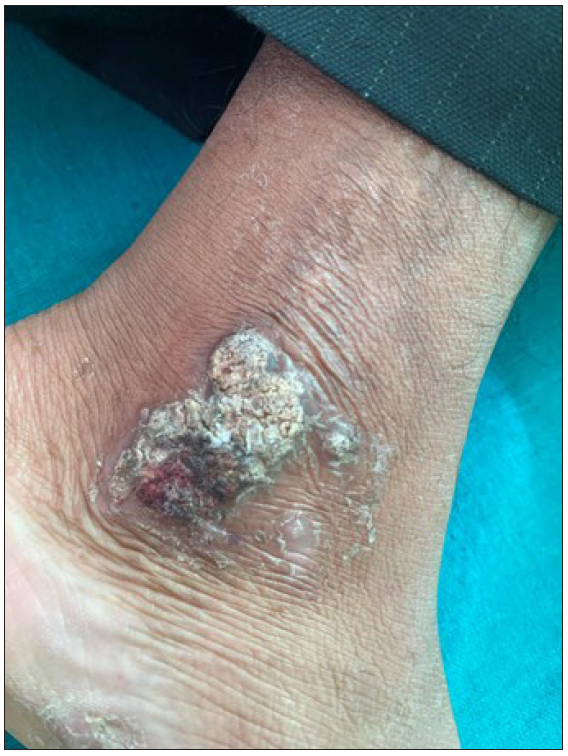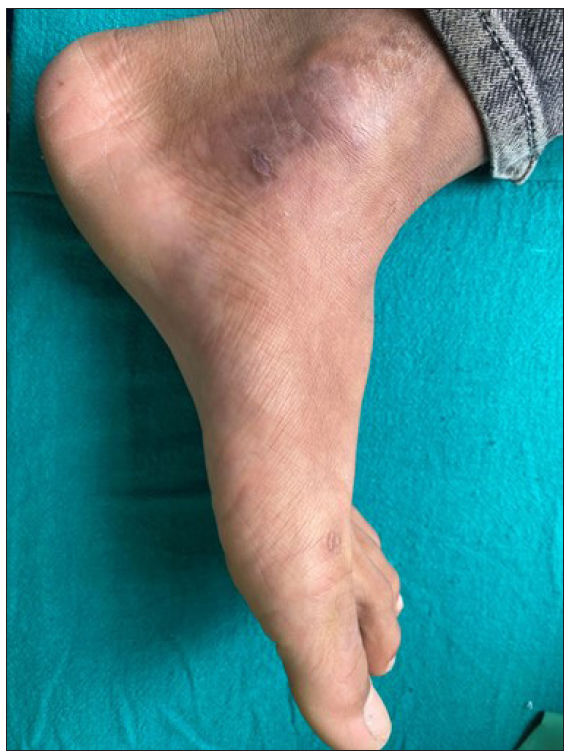Translate this page into:
Porokeratosis ptychotropica without genitogluteal involvement – A rare presentation
Corresponding author: Dr. Tsering Dolma Gurung, Department of Dermatology, Maharajgunj Medical Campus, Maharajgunj, Kathmandu, Nepal, Kathmandu, Nepal. tserindg@gmail.com
-
Received: ,
Accepted: ,
How to cite this article: Gurung TD, Parajuli S. Porokeratosis ptychotropica without genitogluteal involvement – A rare presentation. Indian J Dermatol Venereol Leprol. doi: 10.25259/IJDVL_459_2024
Dear Editor,
Porokeratosis ptychotropica (PP) is a rare variant of porokeratosis. Very few cases of PP are reported worldwide. We present a case of PP with no genitogluteal involvement which has been reported only once before. An 18-year-old boy visited the dermatology outpatient department with the complaint of a single lesion over his left ankle for one year. The lesion was slightly itchy and had gradually increased in size. On examination, a single well-defined hyperkeratotic verrucous plaque of size 3×3 cm2 was present on the left medial malleolus [Figure 1]. Clinical differential diagnoses were lichen simplex chronicus, deep mycosis, cutaneous tuberculosis, and squamous cell carcinoma. An incisional biopsy from the lesion was done. Histopathology revealed an acanthotic epidermis with elongation of rete ridges and focal parakeratosis, multiple lamellae composed of parakeratotic cells with loss of granular layer beneath the parakeratotic zone, and moderate perivascular lymphocytic infiltrates in the superficial dermis. The histopathological findings confirmed the diagnosis of PP [Figure 2]. The patient was prescribed topical tazarotene 0.1% cream once daily for two months. On follow-up, the lesion had improved with no recurrences thereafter [Figure 3].

- Initial presentation with a verrucous plaque on the medial malleolus.
![Histopathology of the plaque showing acanthosis, elongated rete ridges, and multiple cornoid lamellae [Haematoxylin and Eosin, 40x].](/content/126/2024/0/1/img/IJDVL_459_2024-g2.png)
- Histopathology of the plaque showing acanthosis, elongated rete ridges, and multiple cornoid lamellae [Haematoxylin and Eosin, 40x].

- Near complete clearance of the lesion after two months of treatment with topical tazarotene.
Porokeratosis is a keratinisation disorder due to abnormal clonal expansion and differentiation of keratinocytes. The prevalence of porokeratosis was found to be 24.2 per 100,000 population.1 Germline mutation of mevalonate pathway genes has been postulated to be the underlying cause of porokeratosis.1 PP is a rare hyperkeratotic variant of porokeratosis. The term porokeratosis ptychotropica is derived from the words ‘ptyché’ meaning folds and ‘tropé’ meaning a turning which was coined by Lucker et al. in 1995.2 PP most commonly affects the gluteal cleft with or without involving the extremities. There is only one case reported of PP not involving genito-gluteal region, similar to our case.3 It is clinically characterised by pruritic thick hyperpigmented verrucous plaques in a butterfly configuration that can simulate viral warts, hypertrophic lichen planus, lichen simplex chronicus, psoriasis, perforating disorders, squamous cell carcinoma, deep mycosis, and tuberculosis verrucosa cutis. The classical histopathologic feature of PP is the presence of multiple layers of cornoid lamellae throughout the lesion unlike other variants of porokeratosis with cornoid lamellae only at the periphery.4 There are also some reports of the presence of dermal amyloid deposits noted on histopathology.5 PP is usually resistant to treatment. Various treatment modalities include topical retinoids, imiquimod, 5-fluorouracil, isotretinoin, photodynamic therapy, cryotherapy, carbon dioxide laser, and excision.6 Around 7.5% of porokeratotic lesions undergo malignant transformation. There is a case report of PP developing into squamous cell carcinoma after 18 years.7 Therefore, long-term follow-up of PP is essential.
In conclusion, though most of the cases of PP are present in the genitogluteal region, these regions can rarely be spared. So, PP should always be considered in the differential diagnosis of a hyperkeratotic verrucous lesion to avoid misdiagnosis and a delay in diagnosis, thus preventing long-term complications and malignant transformation.
Declaration of patient consent
The authors certify that they have obtained all appropriate patient consent.
Financial support and sponsorship
Nil.
Conflicts of interest
There are no conflicts of interest.
Use of artificial intelligence (AI)-assisted technology for manuscript preparation
The authors confirm that there was no use of artificial intelligence (AI)-assisted technology for assisting in the writing or editing of the manuscript and no images were manipulated using AI.
References
- Porokeratosis is one of the most common genodermatoses and is associated with an increased risk of keratinocyte cancer and melanoma. J Eur Acad Dermatol Venereol. 2023;37:420-7.
- [CrossRef] [PubMed] [PubMed Central] [Google Scholar]
- An unusual case of porokeratosis involving the natal cleft: Porokeratosis ptychotropica? Br J Dermatol. 1995;132:150-1.
- [CrossRef] [PubMed] [Google Scholar]
- A case report of porokeratosis ptychotropica without genitogluteal involvement. Thai J Dermatol. 2020;36:186-90.
- [Google Scholar]
- Porokeratosis ptychotropica: A rare and evolving variant of porokeratosis. J Cutan Pathol. 2013;40:1042-7.
- [CrossRef] [PubMed] [Google Scholar]
- Porokeratosis ptychotropica associated with dermal amyloid deposits. Clin Exp Dermatol. 2003;28:450-2.
- [CrossRef] [PubMed] [Google Scholar]
- Porokeratosis ptychotropica: A case report. J Yeungnam Med Sci. 2023;40:423-5.
- [CrossRef] [PubMed] [PubMed Central] [Google Scholar]
- Transformation of porokeratosis ptychotropica into invasive squamous cell carcinoma. Int J Dermatol. 2017;56:679-80.
- [CrossRef] [PubMed] [Google Scholar]





